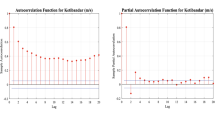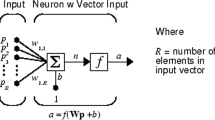Abstract
This study presents the generation of a nonlinear autoregressive exogenous model (NARX) for wind speed forecasting in a 1 h, in advance horizon. A sample of meteorological data of hourly measurements taken during a year was used for the generation of the model. The variables measured were as follows: wind speed, wind direction, solar radiation, pressure, and temperature. All measurements were taken by the Comision Federal de Electricidad (CFE) at La Mata, in the state of Oaxaca, Mexico. Using the Mahalanobis distance, the sample of data was treated in order to detect deviated values in multivariable samples. Later on, the statistical Granger test was conducted to establish the entry variables that would be incorporated into the model. Since solar radiation was the only one determined as the cause for wind speed, it was the variable used in the configuration of the model. To compare the NARX model, a one-variable, nonlinear autoregressive model (NAR) was also generated. Both models, the NARX and the NAR were compared against the persistence model by means of applying the statistical error forecast measurements of mean absolute error, mean squared error, and mean absolute percentage error to the test data. The results showed the NARX model as the most precise of the three, reflecting the importance of the inclusion of additional meteorological variables in the wind speed forecasting models.
















Similar content being viewed by others
References
Global Wind Energy Council (GWEC) (2014) Global Wind Statistics 2013. Brussels, Global Wind Energy Council
Cadenas R, Saldívar G (2007) Wind power plant La Venta II. Revista Digital Universitaria 8(12):1–12
Centro Nacional de Control de Energía (CENACE) (2001) Reglas de despacho y operación del sistema eléctrico nacional, México
Cadenas E, Rivera W (2009) Short term wind speed forecasting in La Venta, Oaxaca, Mexico, using artificial neural networks. Renew Energy 34:274–278
Salcedo-Sanz S, Pérez-Bellidoa AM, Ortiz-García EG, Portilla-Figueras A, Prieto L, Paredes D (2009) Hybridizing the fifth generation mesoscale model with artificial neural networks for short-term wind speed prediction. Renew Energy 34:1451–1457
Cadenas E, Jaramillo OA, Rivera W (2010) Analysis and forecasting of wind velocity in Chetumal, Quintana Roo, using the single exponential smoothing method. Renew Energy 35:925–930
Li G, Shi J (2010) On comparing three artificial neural networks for wind speed forecasting. Appl Energy 87:2313–2320
Liu H, Tian H, Chen C, Li Y (2010) A hybrid statistical method to predict wind speed and wind power. Renew Energy 35:1857–1861
Cadenas E, Rivera W (2010) Wind speed forecasting in three different regions of Mexico, using a hybrid ARIMA–ANN model. Renew Energy 35:2732–2738
Li G, Shi J, Zhou J (2011) Bayesian adaptive combination of short-term wind speed forecasts from neural network models. Renew Energy 36:352–359
Liu H, Erdem E, Shi J (2011) Comprehensive evaluation of ARMA–GARCH(-M) approaches for modeling the mean and volatility of wind speed. Appl Energy 88:724–732
Guo Z, Zhao W, Lu H, Wang J (2012) Multi-step forecasting for wind speed using a modified EMD-based artificial neural network model. Renew Energy 37:241–249
Liu H, Tian H, Li Y (2012) Comparison of two new ARIMA–ANN and ARIMA–Kalman hybrid methods for wind speed prediction. Appl Energy 98:415–424
Cassola F, Burlando M (2012) Wind speed and wind energy forecast through Kalman filtering of numerical weather prediction model output. Appl Energy 99:154–166
Zhang W, Wu J, Wang J, Zhao W, Shen L (2012) Performance analysis of four modified approaches for wind speed forecasting. Appl Energy 99:324–333
Liu H, Chen C, Tian H, Li Y (2012) A hybrid model for wind speed prediction using empirical mode decomposition and artificial neural networks. Renew Energy 48:545–556
Peng H, Liu F, Yang X (2013) A hybrid strategy of short term wind power prediction. Renew Energy 50:590–595
Chen K, Yu J (2014) Short-term wind speed prediction using an unscented Kalman filter based state-space support vector regression approach. Appl Energy 113:690–705
Hocaoğlu FO, Gerek ON, Kurban M (2010) A novel wind speed modeling approach using atmospheric pressure observations and hidden Markov models. J Wind Eng Ind Aerodyn 98:472–481
Hocaoğlu FO, Fidan M, Gerek ON (2009) Mycielski. Approach for wind speed prediction. Energy Convers Manag 50:1436–1443
De Maessc-Halck R, Jouan-Rimbaud D, Massart DL (2000) The Mahalanobis distance. Chemometr Intell Lab Syst 50:1–18
Filzmoser P (2005) Identification of multivariate outliers: a performance study. Aust J Stat 34:127–138
Hocaoğlu FO, Karanfil F (2013) A time series-based approach for renewable energy modeling. Renew Sustain Energy Rev 28:214
Dickey DA, Fuller WA (1981) Likelihood ratio statistics for autoregressive processes. Econometrica 49:1057–1072
Gao Y, Er MJ (2005) NARMAX time series model prediction: feedforward and recurrent fuzzy neural network approaches. Fuzzy Sets Syst 150(2):331–350
Kubat M (1999) Neural networks: a comprehensive foundation by Simon Haykin. Knowl Eng Rev 13:409–412
Gardner M, Dorling S (1998) Artificial neural networks (the multilayer perceptron)—a review of applications in the atmospheric sciences. Atmos Environ 32:2627–2636
Diaconescu E (2008) The use of NARX neural networks to predict chaotic time series. WSEAS Trans Comput Res 3(3):182–191
Pravin C, Yogesh S (2004) An activation function adapting training algorithm for sigmoidal feedforward networks. Neurocomputing 61:429–437
Makridakis HR, Wheelwright S (1998) Forecasting methods and applications, 3rd edn. Wiley, Hoboken
Shahin MA, Maier HR, Jaksa MB (2004) Data division for developing neural networks applied to geotechnical engineering. J Comput Civil Eng ASCE 18(2):105–114
Acknowledgments
The authors wish to thank the Comisión Federal de Electricidad (CFE) for the special considerations given in the preparation of this study.
Author information
Authors and Affiliations
Corresponding author
Rights and permissions
About this article
Cite this article
Cadenas, E., Rivera, W., Campos-Amezcua, R. et al. Wind speed forecasting using the NARX model, case: La Mata, Oaxaca, México. Neural Comput & Applic 27, 2417–2428 (2016). https://doi.org/10.1007/s00521-015-2012-y
Received:
Accepted:
Published:
Issue Date:
DOI: https://doi.org/10.1007/s00521-015-2012-y




